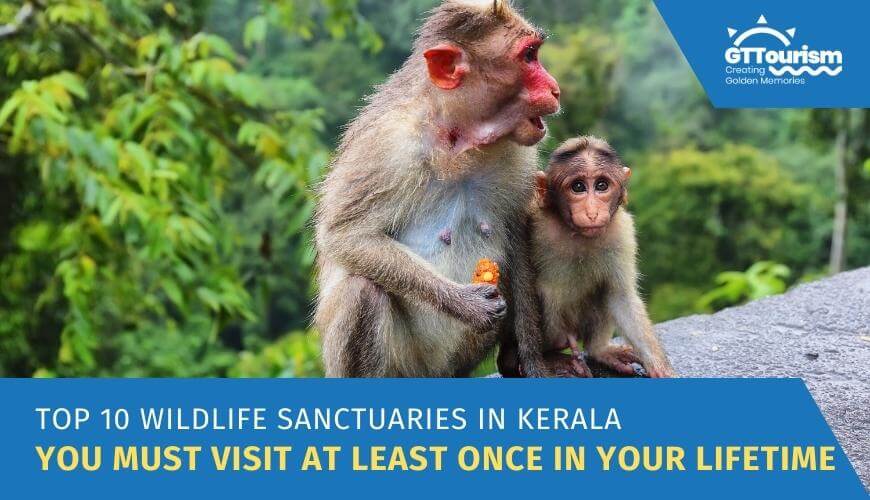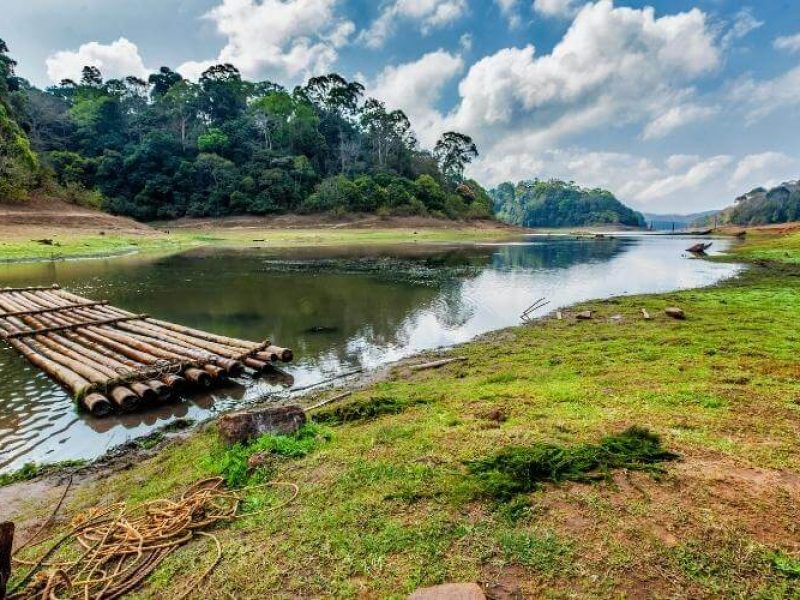Kerala is a blessed place with verdant green forests covering a little over 29% of the state. It has been ranked third among the top five states in India with increasing forest cover. And thanks to a culture that believes in synergistic and symbiotic harmony with nature, the state has steadily improved its forest cover. Its rich biodiversity is considered a repository of rare and endangered plants and animals, some of which are endemic to the region.
It is one of the very few states that has made environmental conservation a successful business model. Besides tea estates, backwaters, and beaches, the state’s wildlife sanctuaries are a huge tourist attraction. While the state has over 18 wildlife sanctuaries, five national parks, and one community reserve, some are more popular than others, attracting millions of tourists from India and abroad. Here, we list the top 10 wildlife sanctuaries in Kerala that you mustn’t miss:
1. Periyar Wildlife Sanctuary
This is Kerala’s largest and the first wildlife sanctuary, covering over 925 sq km and encompassing two districts – Idukki and Pathanamthitta. The sanctuary is famous for its tiger and elephant reserves, established in 1978 and 1992, respectively. It gets its name from the Periyar River, a perennial river that originates from the Sivagiri Hills and supplies water to several districts in the state. Besides Periyar, the sanctuary is famous for Pamba, an artificial river formed due to the Mullaiperiyar Dam.
Popular Attractions in the Sanctuary
The Periyar Tiger Reserve
The tiger reserve covers over 777 sq km. It is home to hundreds of animals, including wild pigs, Malabar wild squirrels, gaurs, sambars, Nilgiri tahrs, birds like the Malabar grey hornbills, Nilgiri wood pigeons, blue-winged parakeets, eagle owls, butterflies and moths, fishes, and even invertebrates. And, of course, the tiger as well.
Elephant Reserve
The elephant reserve was established in 1992 and is home to over 1000 Asian elephants. Tourists can watch herds of elephants playing and going about their daily lives. The elephant safari includes an hour’s ride with an elephant, witnessing an elephant bath, a shower, and a photo session.
Activities Include
Jeep jungle safari, elephant safari, tiger trail, bamboo rafting, nature walk, pugmark trail, camping & trekking, boating, and tree house lodging.
Best Time to Visit the Sanctuary
- September to June
2. Eravikulam Wildlife Sanctuary
The Eravikulam Wildlife Sanctuary is a UNESCO World Heritage Site covering over 92 sq km and encompassing two districts – Idukki and Ernakulam. It was declared a sanctuary in 1975 and a park in 1978. The sanctuary is home to the endangered Nilgiri tahr, a mountain goat endemic to the shola grasslands, and the Anamudi Peak, the highest peak in South India.
Popular Attractions in the Sanctuary
Neelakurinji Bloom
The neelakurinji is a rare flower that blooms only once in 12 years and is endemic to the Western Ghats. In fact, the local tribals used the bloom to calculate their age. The flower does not have any smell or medicinal value but grows on the grasslands in the forests.
Wildlife
This famous wildlife sanctuary in Kerala is home to over 30 species of mammals, including the Nilgiri tahr, gaur, sloth, Nilgiri langur, and the Malabar giant squirrel. It is also home to civet cats, jungle cats, panthers, birds, various species of butterflies, and the atlas moth, the world’s largest moth.
Activities Include
Trekking, camping at the Lakkom Log House, jeep safari, and jungle safari.
Best Time to Visit
- September to February.
Note
The sanctuary is closed from February to March as breedings season begins for Nilgiri Tahr.
3. Aralam Wildlife Sanctuary
This is Kerala’s third-largest wildlife sanctuary, established in 1984 and spread over 55 sq km. The sanctuary is located in Kannur and sits amidst the Brahmagiri Hills in Kodagu and the Thirunelli Hills in Wayanad, with the Cheenkanni River flowing within the park. The Aralam Wildlife Sanctuary is home to a wide range of flora and fauna, including elephants, gaur, spotted deer, barking deer, langur, and the Malabar giant squirrel. But what makes Aralam one of the best wildlife sanctuaries in Kerala are the rare butterflies, dragonflies and damselflies. Among the bird species, you can find over two hundred birds, including the wood pigeon. And if you are looking for reptiles and amphibians, Aralam Wildlife Sanctuary is home to the king cobra and the Cochin forest cane turtle.
Popular Attractions in the Sanctuary
Meenmutty Falls
The Road To The Cascade is a jeep safari into the heart of the Aralam Wildlife Sanctuary to Meenmutty Falls. The 15km jeep ride takes you through the inner depths of the forest, where a guide will help you understand the surrounding landscape. The Meenmutty Falls is special because of the water that cascades from over 900 feet in three separate levels and is the second-highest waterfall in Kerala.
Cheenkanni River
The Cheenkanni River originates from the Bramhagiri Hills and flows through the dense forests of the Aralam Sanctuary. The water is crystal clear and full of minerals thanks to the medicinal plants and trees the river passes through. The Call of the River program takes tourists through the banks of this river for 2 km, up to the Pookkund region, where you can witness the amazing mud puddling. A guide accompanying you offers insight into the forests and butterflies in this region.
Activities Include
Bamboo rafting, nature trail, trekking to the Pothanplavu watch tower, and more.
Best Time to Visit
- November to May
4. Parambikulam Wildlife Sanctuary
The Parambikulam Wildlife Sanctuary was established in 1973 and is part of the Nemmara Forest Division in the Palakkad district. The sanctuary stretches up to 69 sq km and is famous for its panoramic landscape, meandering streams, and waterfalls. The sanctuary is also known for becoming the first scientifically managed teak plantation. It is also home to Kannimara, the world’s oldest teak tree that locals revere and consider sacred. It is believed the tree has continued to grow – almost by 1.85 cm in height and 9 cm in girth, over the last five years.
Popular Attractions Include
Jungle Safari
Tourists are taken to the heart of the sanctuary, covering over 53 km, where you can observe the sanctuary’s rare and endemic animals and birds, including leopards, elephants, langurs, sloths, sambars, and gaurs. The safari takes around 3 hours to complete and is accompanied by trained drivers and naturalists belonging to the local tribe.
A Day in Parambikulam
This program helps tourists spend an entire day in the sanctuary undertaking exciting activities like trekking, bamboo rafting, etc. Guests can shop for eco-friendly souvenirs and gifts, enjoy scrumptious lunch, and visit the Kannimara teak.
Activities Include
Jungle safari, bamboo rafting, trekking trails like elephant trails, pugmark trails, bear path trekking, etc.
Best Time to Visit
October to March are the best months because the weather is pleasant and breezy.
5. Wayanad Wildlife Sanctuary
The Wayanad Wildlife Sanctuary was established in 1973 to conserve the ecologically sensitive Nilgiri Biosphere Reserve. Covering an area of 344 sq km and encompassing four hills, viz., Sulthan Bathery, Muthanga, Kurichiat and Tholpetty, this is the second largest wildlife sanctuary in Kerala. The sanctuary is home to rare and endemic plants and animals, including the gaur, Asian elephant, deer, and tiger. Some of the oldest inhabitants of this sanctuary, viz. the Paniyans, Kurubas, and the Adiyans, have lived at least ten centuries before Christ.
Popular Attractions in Wayanad Wildlife Sanctuary
Elephant Training Centre
The sanctuary operates a special elephant training camp where baby elephants are trained to become Kumkis. To the uninitiated, a kumki elephant is trained to help forest conservationists send wild elephants back to the forest. Tourists can visit the training centre to watch the mahouts teach these pachyderms to obey various commands, including convincing elephants not to harm humans while entering the human territory.
Jeep Safari
The safari includes a forest guide taking you through the forest to help you understand the different flora and fauna species, including wild animals like tigers, Asian elephants, deer, and peacocks.
Activities Include
Jeep safari, birding tour, elephant ride, and nature trail.
Best Time to Visit
August to February, when the weather is pleasant and temperatures moderate.
6. Idukki Wildlife Sanctuary
The Idukki Wildlife Sanctuary was established in 1984 to conserve the rich biodiversity around the Idukki Reservoir. It is popular because of the presence of the Idukki Arch Dam, Kerala’s first hydroelectric project. The sanctuary is spread over 77 sq km, stretching Udumpanchola and Thodupuzha. In the sanctuary, one can spot elephants, porcupines, sambhars, Malabar giant squirrels, and wild boars. You can also take a boat ride on the dam reservoir, which takes around 3 hours, starting from Nellikkappara to Kulamavu.
Popular Attractions in the Sanctuary
Birding Trails
Some popular birding trails organized within the sanctuary include – the Salim Ali Bird Trail, the Malabar Trogon Trail, and the Black Baza Trail. These are short trails and are best undertaken in the afternoon.
Activities Include
Wildlife safari, boating, forest walks, trekking, camping, etc.
Best Time to Visit
- December to April
7. Kumarakom Bird Sanctuary
The Kumarakom Bird Sanctuary was established around 1847 and spread around 14 acres to conserve the avian creatures in and around Lake Vembanad. The sanctuary is a great place to observe various migratory birds, including white ibis, Siberian cranes, parrots, and teals. Some local birds you can observe in the sanctuary include waterfowls, cuckoos, owls, egrets, herons, and woodpeckers.
Activities Include
- Boating, bird watching
Best Time to Visit
- June to August
8. Silent Valley National Park
The Silent Valley National Park is spread across 237 sq km and was established in 1984. It covers the districts of Palakkad and Malaparram and is located in the heart of the Nilgiri Hills. The area around the national park is called Saiandhrivanam, which in Malayalam means Sairandhani’s Forest. It is believed that the Pandavas spent their exile in these forests. Some of the attractions in the national park include Ceylon frogmouths, Great Indian hornbill, Nilgiri tahr, and threatened lion-tailed macaque.
Activities Include
Wildlife safari, bird watching, trekking etc.
Best Time to Visit
- December to January
9. Peppara Wildlife Sanctuary
The Peppara Wildlife Sanctuary was established in 1983 and is named after the Peppara Dam, built on the Karamana River to provide drinking water to Thiruvananthapuram city and suburbs. The sanctuary covers around 75 sq km, including the catchment areas of the Karamana River. The entire sanctuary comes under the Agasthyamala Biosphere Reserve and is home to the endangered Myristica swamps endemic to the area.
Activities Include
Trekking, birdwatching, nature trails, etc.
Best Time to Visit
March to July and September to November
10. Chinnar Wildlife Sanctuary
The Chinnar Wildlife Sanctuary was established in 1984 to protect the rich biodiversity of the Marayoor range. This is the best wildlife sanctuary in Kerala and critical to the survival of the critically endangered great grizzled squirrel, with less than 200 in existence. It is also worth visiting to appreciate the sandalwood trees that grow abundantly around the place. Some animals found here include langurs, peacocks, spotted deer, etc.
Popular Attractions in the Sanctuary
Thoovanam Falls
The falls are formed by the Pambar River, cascading from a height of 84 feet. You can trek towards the falls from the Alampetty Check Post, walking for about 3 hours and admiring the beautiful plants and animals along the way.
Activities Include
Nature trails, trekking to Thoovanam Waterfalls, staying at the log house, etc.
Call our travel agency in Kochi if you’d like to explore the various famous wildlife sanctuaries in Kerala. Visit us!




Comment (0)